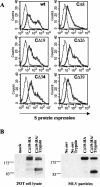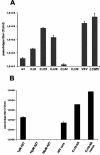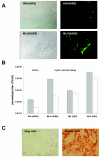Retroviral vectors pseudotyped with severe acute respiratory syndrome coronavirus S protein
- PMID: 15308697
- PMCID: PMC506966
- DOI: 10.1128/JVI.78.17.9007-9015.2004
Retroviral vectors pseudotyped with severe acute respiratory syndrome coronavirus S protein
Abstract
The worldwide outbreak of severe acute respiratory syndrome (SARS) was shown to be associated with a novel coronavirus (CoV) now called SARS CoV. We report here the generation of SARS CoV S protein-pseudotyped murine leukemia virus (MLV) vector particles. The wild-type S protein pseudotyped MLV vectors, although at a low efficiency. Partial deletion of the cytoplasmic tail of S dramatically increased infectivity of pseudotypes, with titers only two- to threefold lower than those of pseudotypes generated in parallel with the vesicular stomatitis virus G protein. S-pseudotyped MLV particles were used to analyze viral tropism. MLV(SARS) pseudotypes and wild-type SARS CoV displayed similar cell types and tissue and host restrictions, indicating that the expression of a functional receptor is the major restraint in permissiveness to SARS CoV infection. Efficient gene transfer could be detected in Vero and CaCo2 cells, whereas the level of gene marking of 293T, HeLa, and HepG2 cells was only slightly above background levels. A cat cell line and a dog cell line were not susceptible. Interestingly, PK-15, a porcine kidney cell line, and primary porcine kidney cells were also highly permissive for SARS S pseudotypes and wild-type SARS CoV. This finding suggests that swine may be susceptible to SARS infection and may be a source for infection of humans. Taken together, these results indicate that MLV(SARS) pseudotypes are highly valuable for functional studies of viral tropism and entry and, in addition, can be a powerful tool for the development of therapeutic entry inhibitors without posing a biohazard to human beings.
Figures






Similar articles
-
S protein of severe acute respiratory syndrome-associated coronavirus mediates entry into hepatoma cell lines and is targeted by neutralizing antibodies in infected patients.J Virol. 2004 Jun;78(12):6134-42. doi: 10.1128/JVI.78.12.6134-6142.2004. J Virol. 2004. PMID: 15163706 Free PMC article.
-
Contributions of the structural proteins of severe acute respiratory syndrome coronavirus to protective immunity.Proc Natl Acad Sci U S A. 2004 Jun 29;101(26):9804-9. doi: 10.1073/pnas.0403492101. Epub 2004 Jun 21. Proc Natl Acad Sci U S A. 2004. PMID: 15210961 Free PMC article.
-
Longitudinally profiling neutralizing antibody response to SARS coronavirus with pseudotypes.Emerg Infect Dis. 2005 Mar;11(3):411-6. doi: 10.3201/eid1103.040906. Emerg Infect Dis. 2005. PMID: 15757556 Free PMC article.
-
Vaccine design for severe acute respiratory syndrome coronavirus.Viral Immunol. 2005;18(2):327-32. doi: 10.1089/vim.2005.18.327. Viral Immunol. 2005. PMID: 16035944 Review.
-
SARS-CoV and emergent coronaviruses: viral determinants of interspecies transmission.Curr Opin Virol. 2011 Dec;1(6):624-34. doi: 10.1016/j.coviro.2011.10.012. Curr Opin Virol. 2011. PMID: 22180768 Free PMC article. Review.
Cited by
-
Deletion of the SARS-CoV-2 Spike Cytoplasmic Tail Increases Infectivity in Pseudovirus Neutralization Assays.J Virol. 2021 May 10;95(11):e00044-21. doi: 10.1128/JVI.00044-21. Epub 2021 Mar 16. J Virol. 2021. PMID: 33727331 Free PMC article.
-
Neutralizing antibody responses to SARS-CoV-2 in symptomatic COVID-19 is persistent and critical for survival.Nat Commun. 2021 May 11;12(1):2670. doi: 10.1038/s41467-021-22958-8. Nat Commun. 2021. PMID: 33976165 Free PMC article.
-
Important role for the transmembrane domain of severe acute respiratory syndrome coronavirus spike protein during entry.J Virol. 2006 Feb;80(3):1302-10. doi: 10.1128/JVI.80.3.1302-1310.2006. J Virol. 2006. PMID: 16415007 Free PMC article.
-
Pseudotyped Viruses.Adv Exp Med Biol. 2023;1407:1-27. doi: 10.1007/978-981-99-0113-5_1. Adv Exp Med Biol. 2023. PMID: 36920689
-
Ribavirin and interferon-beta synergistically inhibit SARS-associated coronavirus replication in animal and human cell lines.Biochem Biophys Res Commun. 2005 Jan 28;326(4):905-8. doi: 10.1016/j.bbrc.2004.11.128. Biochem Biophys Res Commun. 2005. PMID: 15607755 Free PMC article.
References
MeSH terms
Substances
LinkOut - more resources
Full Text Sources
Other Literature Sources
Miscellaneous

